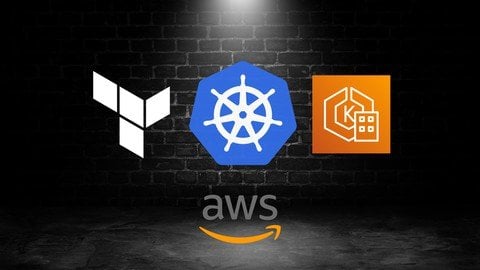
Published 5/2023
MP4 | Video: h264, 1280×720 | Audio: AAC, 44.1 KHz
Language: English | Size: 1.06 GB | Duration: 2h 3m
Hands on Get Started guide tailored for Developers, Cloud Engineers and DevOps Professionals
What you’ll learn
You’ll learn creating deploying multiple docker applications on Kubernetes
You’ll learn basic security best practices of deploying applications on Kubernetes
You’ll learn how to create Kubernetes cluster on Amazon / AWS EKS using Terraform
You’ll learn creating necessary infrastructure such as VPC on AWS using Terraform
You’ll learn creating RDS MySQL database using Terraform for a docker API application
You’ll learn how to use Command Line Interface and Infrastructure Code instead of using AWS Management Console
Requirements
You are a web developer and understand the concepts of web programing
You have basic knowledge of Docker. If you have the experience building images, even for local development, that is a plus
You have or you will create AWS account and aware of the pricing beyond AWS free tier
Description
A Get Started and a practical course that is packed with learning content. We’ll show you how to create a Kubernetes cluster and deploy Docker containers to K8S on AWS EKS, all at a quick pace. Plus, learn to code Cloud Infrastructure with Terraform.Learn about Infrastructure & Networking for Kubernetes setup on AWS:You will gain knowledge about the infrastructure requirements for running Kubernetes on AWS, including understanding the networking concepts and components involved in setting up a Kubernetes environment.Create Kubernetes cluster on AWS EKS by writing Terraform code: This objective focuses on using Terraform, an infrastructure-as-code tool, on provisioning and configure the AWS resources required for setting up an Amazon Elastic Kubernetes Service (EKS) cluster. You will learn how to write Terraform code to automate the cluster creation process.Creates AWS RDS instance for MySQL using Terraform:You will learn to use Terraform to provision an Amazon RDS (Relational Database Service) instance running MySQL. This objective helps in understanding how to integrate and manage databases within a Kubernetes environment.Deploy Microservices as containers to Kubernetes using Kubectl:This objective covers the deployment process of microservices as containers to the Kubernetes cluster. You will learn how to use the kubectl command-line tool to interact with the Kubernetes API and deploy their applications effectively.Learn how to handle the Routing and Load Balancing of Microservices in K8S:You will understand the concepts and practices related to routing and load balancing in Kubernetes. Also, learn how to configure and manage the routing and load balancing of microservices within the Kubernetes cluster.Learn basic security: Config & Secret Configs & Secure Docker Images, etc:This objective covers the fundamentals of securing Kubernetes deployments on AWS. You will learn how to manage sensitive configuration data using Kubernetes ConfigMaps and Secrets and explore best practices for securing Docker images used in containerized applications.
Overview
Section 1: Introduction
Lecture 1 Welcome
Lecture 2 Course Structure
Lecture 3 What you need to know
Section 2: AWS Infrastructure for Kubernetes
Lecture 4 VPC – High Level Overview
Lecture 5 Configure AWS Command Line Interface (CLI)
Lecture 6 Create VPC for Kubernetes using Terraform Code
Lecture 7 VPC Simplified Usage
Lecture 8 Create EKS Kubernetes Cluster using Terraform Code
Section 3: Microservices Deployments on Kubernetes
Lecture 9 Overview of Demo Project – Microservices Product
Lecture 10 High Level Kubernetes Concepts
Lecture 11 Run a Static Website with Docker on Local Setup
Lecture 12 Deploy Static Website to Kubernetes
Lecture 13 Run an API application with Database using Docker Compose
Lecture 14 Create MySQL on AWS RDS using Terraform
Lecture 15 Deploy API application to Kubernetes
Section 4: AWS LoadBalancer and Routing in Kubernetes
Lecture 16 Kubernetes Ingress & AWS LoadBalancer – Overview
Lecture 17 Install Kubernetes Ingress Controller
Lecture 18 Configure Route for the Website Service
Lecture 19 Configure Route for API service
Lecture 20 Deploy Single Page App to Kubernetes with a new Route
Section 5: Application Configs and Secrets Configs in Kubernetes
Lecture 21 Use K8S ConfigMaps for API’s Configurations
Lecture 22 Use K8S Secrets for API’s Secret Configs
Lecture 23 Use Private Docker Registry with Kubernetes
Section 6: Wrapping Up
Lecture 24 Summary
Lecture 25 References
If you’re a DevOps Professional with experience in creating CI/CD pipelines and have a good understanding of high level Cloud Infrastructure and setup, this course will help you gain expertise in Kubernetes and Infrastructure Coding with Terraform on AWS.,If you’re an Engineering Leader seeking to enhance your knowledge of Cloud Engineering, Cloud Native and DevOps practices, particularly in the area of Kubernetes infrastructure for Microservices, this course is perfect for you.,If you’re a Cloud Engineer with experience in Cloud Infrastructure & Networking, and looking to learn Kubernetes from both an Infrastructure Coding and Deployment perspective, this course is for you.,If you’re an Application Engineer with experience in engineering web applications and APIs, this course is tailored for you.
Password/解压密码www.tbtos.com
转载请注明:0daytown » Kubernetes On Aws Eks: Get Started For Developers & Devops